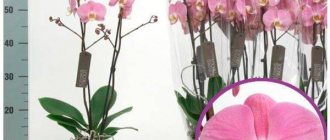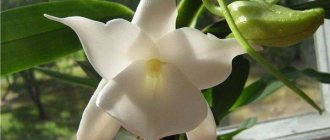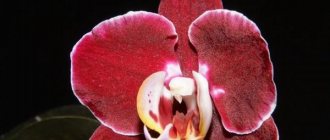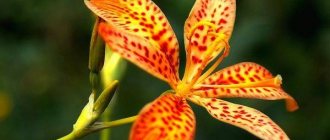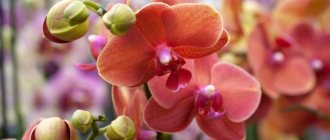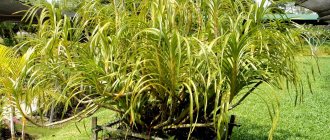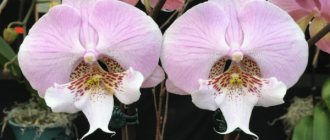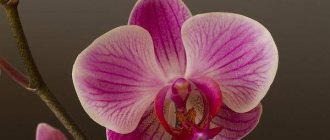Among the beautiful “butterflies” - exclusive orchids there are representatives are completely different in appearance.
Some varieties of this plant are unpretentious and do not require close attention. Others, on the contrary, are so capricious that it is better for novice gardeners not to deal with them. Knowledge about the characteristics of orchids is necessary to provide comfortable conditions for the plant and ensure its continued flowering. Find out what features of orchid varieties have: Lycasta, Lelia, Liparis, Leerdam.
Lycasta
The low Lycaste orchid produces a peduncle from the base of the bulb; its length can reach 25 cm, depending on the variety. Cultivated species have brighter and larger flowers than their wild ancestors. The diameter of the flower reaches 15 centimeters.
Lycastus Orchid.
There is one waxy “butterfly” on the peduncle, rarely two, endowed with a subtle pleasant aroma. Sepals and petals often differ in color. The petals point upward in an arch above the lip. Lycasta has folded, dense leaves; the bulbs are oval or pear-shaped.
The plant's homeland is the tropical zone of South America. The distribution area of Lacasta depends on natural conditions. Preferring fresh air and high mountain areas, the flower can grow in Guatemala, where it is revered as national and is called the “White Nun”. The fragrant Licasta variety is common in Mexico.
Orchid colors can be different: white, orange and pink. But the main color of this variety is yellow.
Features of the flowering of this variety of orchids are the presence of many peduncles that produce flowers almost simultaneously.
The duration of flowering of “butterflies” can last up to a month ; that is how long they can delight flower growers with their beautiful appearance.
The dormant period at home begins in the fall , it can be determined by the falling of yellowed leaves. At this time, watering stops for fourteen days. We keep the container with the flower in a bright room with a temperature of about 12 degrees.
Important! We pay attention to the condition of the bulbs and do not allow them to dry out.
Types of Lycaste orchids:
- Skinner It is considered the most beautiful orchid of this genus. Flowers of a white-pink hue, with a diameter of 15 cm, bloom on peduncles up to 35 cm. On the three-lobed white lip, lines and specks of a violet-red hue, its base is dark purple. This splendor is suitable for cutting into beautiful bouquets;
Skinner. - Fragrant or fragrant emits a strong and pleasant odor. The flowers are painted in various shades, but mostly green, yellow and brown. Peduncles of single “butterflies” grow up to 20 cm;
Fragrant. - Bloody - it would seem that the color of her flowers should be red, but Wikipedia did not confirm this - it is the same yellow, just a little closer to orange. You can find the photo below. Spotted sponges are colored in light or completely white shades.
Bloody.
Watch a video about the features of caring for Lycasta after purchase:
General information with photo
Lycasta is a member of the Orchid family. It has many varieties, most of which are epiphytic plants, i.e. growing on trees and not causing them any harm. There are also epilithic species growing on the ground, but their number is small.
In the first case, the role of the root system is played by aerial roots growing from pseudobulbs, which can have an ovoid, flattened or pear-shaped geometry. From the base of each pseudobulb grows one or more elongated folded leaves, elliptical in shape. Peduncles form on leafless pseudobulbs, each bearing one flower. The inner petals of the inflorescence are located close to its middle, the outer corolla is open, often of a different color. A characteristic feature of this type of orchid is the shedding of foliage upon completion of flowering and entering the resting phase.
The basic colors of decorative wax inflorescences are various shades of pink, yellow-orange and light green in the basic varieties. Based on them, a huge number of varietal and hybrid lines with significantly improved decorative qualities have been developed.
Liparis
Liparis are ethereal plants , that is, they can live not in a substrate, but on a simple block, which can be a tree, a piece of bark or a stone.
The orchid genus Liparis got its name from the Greek word for “fat” because of the shine of its wide, large and squat leaves. The plant may have several ovoid tubers, which, like the base of the stem, are “dressed” with leaves.
The plants reach a height of about 20 cm. On the winged-ribbed peduncle there is an inflorescence called a raceme.
The flower, whose diameter is up to 2 cm, consists of:
- lanceolate sepals, which may have “ears”;
- linear petals;
- an ovoid lip directed downwards towards the base, becoming already having waves along the edges.
The ovaries of the flowers are club-shaped with twisted pedicels.
Liparis is an orchid that naturally grows in tropical zones and has up to 300 species. There are varieties growing in Russia. Six species of Liparis orchid are grown in cultivation.
The following colors of the Liparis orchid are found:
- the brightest and largest in diameter “butterflies” are those of the Kumokri ; they can even have a reddish tint;
- bright pinkish flowers in the lily-leaved variety ;
- The Sakhalin orchid does not shine with the brightness of its colors, but surprises with the large size of its blossoming buds.
Campylostalix.
Lily-leaved.
Sakhalinsky.
The remaining varieties of Liparis do not differ in the brightness of their colors. They are inconspicuous, yellowish-green in color.
The plant reacts negatively to fluctuations in air temperatures . For Japanese Leparis, this condition, on the contrary, gives impetus to the beginning of flowering.
The flowering time of this variety of orchids is a little more than a month, usually from late spring to mid-summer.
Important! The dormant period at home is winter, when the plant does not need thorough watering, but it needs cooler rooms.
Lycaste at home: orchid propagation
When growing a plant at home, you cannot use the seed or meristem method. They are suitable for those plants that are grown in a greenhouse or greenhouse. If you are growing a plant at home, on a windowsill, it is best to use the division method when replanting the plant. you need to take an adult plant with a small number of pseudobulbs, immerse it in water, then very carefully remove it from the pot and free the roots from the old substrate. Everything needs to be done very carefully so as not to damage the small roots. The rhizome must be cut using a disinfected sharp knife so that each section has 2-3 pseudobulbs and young growth. The cut areas must be treated with crushed charcoal to prevent the plant from becoming infected with a fungal infection. The cuttings are planted in a fresh substrate and care begins in exactly the same way as for an adult plant.
Promenea
The difference between Promenea orchids is their compact size and sympoidal type of growth. The modified stem of the plant, the rhizome, is in a creeping state.
Small pseudobulbs, ovoid and slightly flattened, are located under the petioles of the lower leaves. The upper, petiolate leaves grow from their tips. They reach 10 cm.
The color of the broadly lanceolate leaves is pale green, slightly grayish. Darker veins stand out on them.
Peduncles growing up to 10 cm are located in the leaf axils. Each blooms with up to 2 flowers, the diameter of which reaches 5 cm.
The Promenea orchid flower consists of:
- three sepals - sepals, lanceolate or oval;
- two oppositely located petals - petals, differing from sepals in shape or color;
- three-lobed lip, a modified petal resembling a shoulder blade, the sides of which are bent vertically;
- curved column.
The flower resembles an open “mouth”, fascinating with its shades.
The colors of the orchid are different for each type of plant:
- at Promenaea citrina only a few burgundy spots on the lobes and lip, and the rest is all yellow;
Promenaea citrina. - Promenaea stapelioides It is striking in the presence of different colors: the lips and column are painted with a dark purple hue from the inside, and there are spots of light colors on them along the edges. The yellow petals have uneven burgundy stripes;
Promenaea stapelioides. - In Promenea freckled, small burgundy dots are located on the surface of the irregularly shaped yellow sepals. Almost the entire surface of the flower is strewn with burgundy spots - freckles of various sizes.
Promenea stapelidae.
The peculiarity of flowering is that the plant can, after dropping its flowers, begin to grow young pseudobulbs. And then the orchid does not need a period of rest. Although such frequent situations can weaken the plant. Flowering duration can be from 4 to 8 weeks.
The rest period at home occurs twice a year. The plant needs winter rest after the pseudobulbs have rounded and sprouts have appeared. It is necessary to reduce watering and lower air temperatures. Dormancy ends with the appearance of flower stalks. The second time the orchid goes into “rest” at the end of flowering. It lasts up to 3 weeks.
You will learn everything about the Promenea orchid from the video below:
Description
The Lycaste orchid produces a waxy flower that lasts quite a long time and is also known for its rounded pseudobulbs and wide leaves. Over time, the plant's pseudobulbs become wrinkled, and the leaves fall off after about 2 years.
This is what the plant looks like during flowering. Photo used as illustration. Source: Yandex.Images
The buds are medium in size (5-7 centimeters), come in various shades and have a delicious aroma with notes of lemon and cinnamon . The flowering period for various Lycast species begins in early spring and ends towards the end of summer.
Lelia
The Lelia orchid got its name from the name of the ancient Greek virgin, the Vestal Virgin, guarding the goddess Vesta, Lelia. The plant belongs to the group of orchids of sympodial growth type; it has creeping stems.
Among the plants of this species there are miniature ones - up to 12 cm in height, and giant ones - up to 1 m . Pseudobulbs of small varieties are oval in shape, while large ones are reed-shaped. Thick leaves feel hard to the touch.
Having a belt-like or elongated oval shape, they are pointed at the ends and slightly folded along the main vein.
A tall peduncle can be “covered with a cover”. Large - up to 10 cm, and sometimes 20 cm, brightly colored flowers are collected in racemes and have a pleasant aroma. The shape of the sepals and petals is slightly pointed, lanceolate. The wavy petals are wider than the belt-shaped sepals. The lip can be solid or three-lobed, and have a smooth or fringed edge. The lip completely hides the column.
Orchid subspecies:
- at Laelia is double-edged at the end of winter, from two to five flowers appear on a peduncle up to 60 cm. Their size is up to 8 cm, colors are light pink or lilac-purple. Ribbed pseudobulbs have an oval-oblong shape, throwing out one or two leaves;
Double-edged. - pseudobulbs Laelia purpurea grow up to 60 cm, throw out one leaf. In spring, the plant blooms with white or pale lilac fragrant flowers, the diameter of which is up to 20 cm. These giant “butterflies” are located on a short peduncle;
Laelia purpurata trilabelo. - Lelia Millera has straight, narrowed pseudobulbs. They look very decorative thanks to the light purple bloom and narrow leaf at the top. In a direct inflorescence there are up to 7 flowers with a diameter of 5 cm, painted purple with an orange-red lip. Blooms for 2.5 weeks in summer.
Miller.
The birthplace of the species is Mexico. The distribution area is in the temperate and subtropical regions of the West Indies and many South American countries.
Orchids come in a wide variety of colors, mainly pink, lilac, lilac and purple shades.
The characteristics and duration of flowering vary among different varieties of this species. The dormant period at home is the autumn-winter period. But more often the plant does not focus on the seasons and begins to rest when a new bulb begins to bloom. The dormant period ends with the release of a peduncle.
Video with personal experience of growing Lelia:
Humidity and watering
The lycaste orchid is a representative of the tropical world and air humidity is as important for it as other environmental factors. The humidity indicator can be within 60%.
If this is not possible , then you can use a humidifier, which will have a beneficial effect on all residents of the room.
Or you can spray the plant frequently with soft warm water, at room temperature, once a day. In summer, you can spray twice: in the morning and in the evening.
to water the lycaste orchid as needed, when the substrate becomes barely moist. Watering can be done by immersing the container with the plant in warm water for 15-25 minutes. When the “soil” has collected the required amount of moisture, the remaining moisture is drained through the drainage holes.
Rules of care
All types of orchids prefer bright places, but without direct sunlight. Sometimes it is necessary to use artificial lighting with fluorescent or phytolamps.
Advice! If the plant has a dormant period, then the air temperature should not exceed 15 degrees. The rest of the time it is possible to reach about 20 degrees.
Watering must be correct:
- moderate, during the rest period;
- be careful not to let water touch young leaves;
- pleasant, for which we use soft, settled water.
It is better to spray with distilled water.
Feeding is carried out during the growing season of the orchid, which often coincides with the beginning of spring.
Stimulation of orchid flowering is carried out by increasing the air temperature, increased watering or spraying under a warm shower. To increase the duration of flowering, you cannot move the container with the plant to another place.
Diseases and pests
Some problems with the condition of the flower are directly related to errors in care. From a lack or excess of lighting, yellowing of the leaves is often observed, and the appearance of black spots on them is associated with spraying and drops of water falling on the leaf plate. Sometimes a slowdown in growth becomes apparent, accompanied by a lack of flowering. There are several reasons for this phenomenon - salinization of the substrate due to untimely replanting and watering with hard water, lack of nutrients, non-compliance with the rest period.
Among the diseases, the most common are various rots caused by fungal or bacterial infections in conditions of excessive moisture.
The most common pests on lycastes are mealybugs and scale insects, and in conditions of low humidity, spider mites also appear. If few insects are found, they are washed off with a 20% soap solution. In case of numerous lesions, plants are treated with insecticides.
Growing problems
Lycasta is sensitive to excessive watering and substrate salinity; it requires annual replanting.
Liparis feels good on blocks that can replace the substrate.
Liparis is recommended to be grown on a block.
Promenea needs to be transplanted only in an emergency, such as salinity or decomposition of the substrate. She is a fan of coolness , prefers 16–21 degrees in summer, 12–15 C in winter.
Lelia needs to be kept cool to bloom in winter, perhaps about 5 degrees. This orchid is quite capricious and is not recommended for novice orchid keepers , since it requires specific conditions that are as close to natural as possible. Requires bright light to promote the formation of flower buds and the growth of pseudobulbs.
Main landing features
To attach the plant to a block, for example, on a large piece of bark, we fix the roots on a sphagnum pad.
We select soil in specialized stores. Only an experienced gardener can prepare the substrate on his own. A high-quality substrate should consist of:
- moss that retains moisture;
- fern roots;
- tree bark;
- some flower soil.
For the Promenea and Lelia orchids, either a substrate made of sphagnum and a piece of pine bark, or a block, is suitable.
Advice! You can use wood, bark and even stone as a substrate for the plant.
We take a container for planting special for orchids: transparent and with drainage holes. This provides the plant roots with light and breathability.
The most important thing in planting technology is not to damage the roots. During an orchid transplant you may find:
- rotting roots or parts of the plant that need to be removed by sprinkling the cut with charcoal;
- the presence of pests that need to be eliminated;
- growth of roots to the walls of the pot, which must be freed without damaging.
Planting and transplanting
As a rule, orchids are bought ready-made. Whether or not to replant a purchased plant immediately after acquisition is a controversial question. You need to carefully examine the specimen for comfortable placement of its roots. If the flower is planted in a small (relative to its size) and, especially, opaque container, replanting must be done as quickly as possible.
Soil for lycaste
The easiest and most reliable way is to use ready-made standard soil intended for orchids. However, unfortunately and for some unknown reason, commercially available formulations do not always meet the requirements of these plants. The finished soil should not contain leaf, garden, or any other soil. Its basis should be pieces of wood (usually pine) bark, to which sawdust and coal, as well as sphagnum or its analogue, can be added. The substrate must be porous, partially transmitting light and absolutely not retaining water.
A sign that the lycaste requires replanting should be darkening of the soil, its crumbling and a possible unpleasant odor.
Choosing a pot
For epiphytic plants, it is important to provide access to light and moisture to their aerial roots, so when planting orchids of this type, you should always choose special transparent pots with a large number of holes in the bottom and, preferably, along the side surface. For decoration, a second, outer pot is used, which should be either very wide or also transparent.
Transplantation process
If the transplant is not an emergency, it should be done only when the plant has flowered. The root system of lycasta is particularly sensitive, so replanting must be done with extreme caution. Having taken the flower out of the pot, its roots are freed from old pieces of bark, carefully removing them with tweezers. In many places, the roots grow together with the bark; in this case, there is no need to touch them or try to separate them. Pieces of the bark of the old substrate, fused with the roots, should be transferred along with them to a new pot. This will not only minimize injury, but will also preserve special microflora, which is very important for this plant. Diseased, dry and rotten roots must be removed, and the cut areas must be sprinkled with charcoal or activated carbon.
Reproduction methods
Asexual methods of propagation of orchids are carried out:
- dividing rhizomes in spring only in large plants;
- lateral shoots separated from the mother;
- cuttings, using apical shoots of monopodial plants;
- old bulbs, planted in a separate container.
Reproduction by division.
Sexual methods of propagation of orchids include the use of seeds, the germination of which is considered a complex process.
